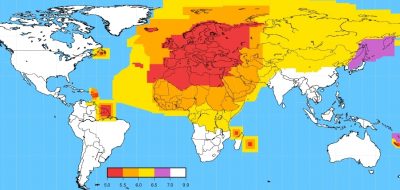Seismic Activity 06/05/2019 – Posted in: Daily News
SEISMIC ACTIVITIES
For: Preliminary & Mains
Topics Covered: Man-Made earthquakes, Injection of fluid into subsurface, Induced seismicity, examples, Impact
News Flash
A new study has revealed that, Seismic activity triggered by human actions like construction of large reservoirs or injection of waste water into the ground for oil and gas production can have far greater implications than previously thought.
Findings of study
- Injection of fluid into subsurface of the earth (one kilometre deep) can cause events like earthquakes.
- Subsurface disturbances due to fluid injection can result in earthquakes spread over larger regions, going far beyond the area invaded by the injected fluids. This means, earthquake-triggering stresses can travel far.
- Oil and gas extraction using fluid injection, as well as wastewater disposal, is known to increase seismicity rate in surrounding regions.
- Tremblors attributed to these activities have been thought to occur as higher fluid pressures in surrounding rocks trigger instabilities in pre-existing networks of faults.
- Injection may also cause a seismic slip — deformation caused along a fault line without any accompanying seismic waves — that may in turn trigger earthquakes.
- When fluid injection occurs near existing faults, their primary response could be slow, quiet, aseismic slip rather than violent earthquakes.
Significance
- Understanding the science behind fluid-induced earthquakes could help in unraveling reservoir-induced earthquakes in Koyna.
- The ‘Deep Drilling at Koyna’ initiative led by Noida-based National Centre for Seismology and CSIR-National Geophysical Research Institute in Hyderabad is studying detailed behaviour of fluid-induced earthquakes in the region.
- These efforts are expected to yield data about fault behaviour at greater depths in the earth’s crust.
Examples of Man-Made Earthquake
- In India, the most famous fluid-induced earthquake had occurred in 1967 at Koyna in Maharashtra and was attributed to seismic activity generated due to the impoundments of the Koyna dam there.
- Earthquakes occurring in tectonically quiet region of Oklahoma have also been linked to oil and gas exploration activity there.
- It is believed that such regions of man-made earthquake activity surpass the level of seismic activity in hotspots like southern California.
Induced seismicity
Induced seismicity refers to typically minor earthquakes and tremors that are caused by human activity that alters the stresses and strains on the Earth’s crust. Most induced seismicity is of a low magnitude. A few sites regularly have larger quakes.
There are many ways in which induced seismicity has been seen to occur. In the past several years, some energy technologies that inject or extract fluid from the Earth, such as oil and gas extraction and geothermal energy development, have been found or suspected to cause seismic events.
Some energy technologies also produce wastes that may be managed through disposal or storage by injection deep into the ground. For example, waste water from oil and gas production and carbon dioxide from a variety of industrial processes may be managed through underground injection.
Source: The Hindu Businessline
You can follow us on LinkedIn and for more updates related to UPSC IAS Preparation, Like our Facebook Page and subscribe our Diligent IAS Youtube Channel
Also Read Related Daily News


